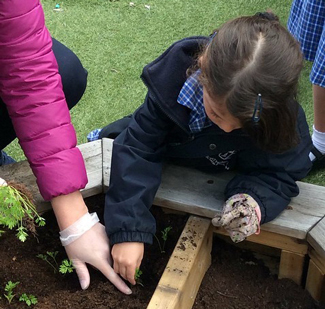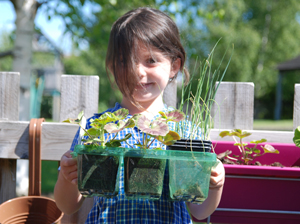Reach For The Sky..... And The Trees, The Soil And Vegetable Patches
 Written by Northampton High School. The digital revolution is very much here. The impact of advancing technology is improving our day to day living and we can see it everywhere we go. But at what cost? The term ‘Nature Deficit Disorder’ – coined by American author, Richard Louv, in 2005 – has now been widely taken up to describe the detrimental effects, on physical and mental health, of children’s disengagement from nature. The stats paint a stark and concerning picture – with a third of under-16s being overweight or obese and an ‘epidemic of mental illness’ afflicting the young (leading to around 35,000 children in England being prescribed anti-depressants). In response, many organisations, such as the National Trust, have taken up the cause of re-engaging children with the Great Outdoors. Schools and Nurseries are, of course, crucial to the success this endeavour. Forest School is a brilliant starting point. Much more than an outdoor education programme, it is a fully integrated and structured programme of activities, underpinned by a wealth of research and risk assessment and combining elements of bushcraft, skills-building, adventure, environmental awareness, character education and personal well-being.
Written by Northampton High School. The digital revolution is very much here. The impact of advancing technology is improving our day to day living and we can see it everywhere we go. But at what cost? The term ‘Nature Deficit Disorder’ – coined by American author, Richard Louv, in 2005 – has now been widely taken up to describe the detrimental effects, on physical and mental health, of children’s disengagement from nature. The stats paint a stark and concerning picture – with a third of under-16s being overweight or obese and an ‘epidemic of mental illness’ afflicting the young (leading to around 35,000 children in England being prescribed anti-depressants). In response, many organisations, such as the National Trust, have taken up the cause of re-engaging children with the Great Outdoors. Schools and Nurseries are, of course, crucial to the success this endeavour. Forest School is a brilliant starting point. Much more than an outdoor education programme, it is a fully integrated and structured programme of activities, underpinned by a wealth of research and risk assessment and combining elements of bushcraft, skills-building, adventure, environmental awareness, character education and personal well-being.
 Forest School demands specialist practitioners but, in other respects, outdoor learning is accessible by all. Enthusiasm and an understanding of what ignites the curiosity of children are the main requirements to make outdoor learning stimulating and effective. Flower beds and vegetable patches, mud kitchens and bug hotels, sensory beds and sandpits, bird feeders and barometers, a trundle wheel and tree-rubbing equipment – the possibilities are endless with a little space and a lot of imagination. Parents, too, can help – and realising what a huge impact even the smallest actions can have is bound to serve as encouragement. Above all, parents, the key is to embrace the Norwegian proverb: There is no such thing as bad weather, only unsuitable clothing while repeating the mantra that: Dirt is not the enemy!
Forest School demands specialist practitioners but, in other respects, outdoor learning is accessible by all. Enthusiasm and an understanding of what ignites the curiosity of children are the main requirements to make outdoor learning stimulating and effective. Flower beds and vegetable patches, mud kitchens and bug hotels, sensory beds and sandpits, bird feeders and barometers, a trundle wheel and tree-rubbing equipment – the possibilities are endless with a little space and a lot of imagination. Parents, too, can help – and realising what a huge impact even the smallest actions can have is bound to serve as encouragement. Above all, parents, the key is to embrace the Norwegian proverb: There is no such thing as bad weather, only unsuitable clothing while repeating the mantra that: Dirt is not the enemy!  Learning where our food comes from, growing things, noticing and understanding the changes of the seasons, making art from natural materials, caring for birds and other wildlife – these are just a few ways that family members can combat Nature Deficit Disorder. Our children can move more freely, look higher, dig deeper, shout louder and think bigger thoughts when the sky is their limit. Bring nature to the forefront at home
Learning where our food comes from, growing things, noticing and understanding the changes of the seasons, making art from natural materials, caring for birds and other wildlife – these are just a few ways that family members can combat Nature Deficit Disorder. Our children can move more freely, look higher, dig deeper, shout louder and think bigger thoughts when the sky is their limit. Bring nature to the forefront at home
- Allocate your child a small area in the garden, a large plant pot or a trough. Plant some flower or vegetable seeds and help your child take responsibility to care of their seeds, watering them, noting their growth and enjoying watching something grow.
- Go on a ‘nature walk’. Arm yourself with a box to collect any particularly interesting twigs or fallen leaves you may see. Take along some pens and paper and try drawing a picture or making a colourful image based on the nature you can see. Try a bit of tree rubbing with a wax crayon!
- Encourage your child to just run… and why not run with them?! Throw off your shoes, open your arms and pretend to fly like a bird. Feel the wind, breathe the fresh air and let your mind be free.
Everyone is welcome to visit Northampton High School, please contact nhs.admissions@nhs.gdst.net to find out more and book a tour.